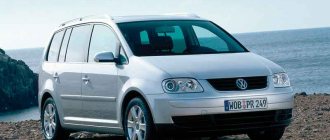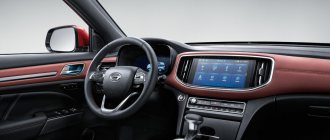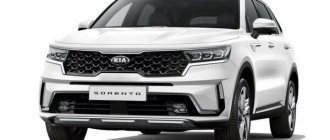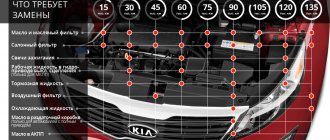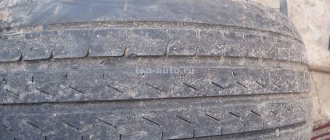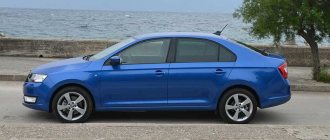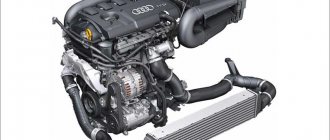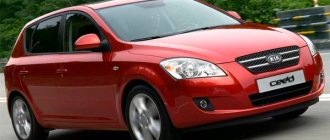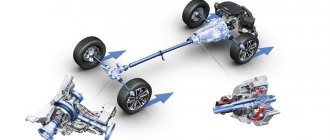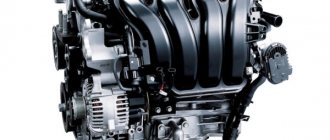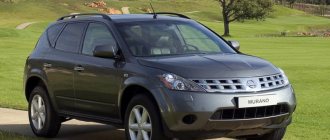Santa Fe, only fresh
Kia Sorento 2 is built on the Hyundai Santa Fe II platform, but looks more modern because it was “drawn” later. The design is the work of Peter Schreyer, one of the most talented stylists thanks to whom Kia achieved success in Europe.
The interior is no less attractive. However, it should be recognized that the precision of fitting of parts and the quality of the plastics used do not reach the level of more prestigious competitors. However, a lot depends on the carefulness of the owner and passengers.
You won't have to complain about the equipment. Even dual-zone climate control is included as standard equipment. The list of options includes: a rear view camera, navigation, a system for easing uphill starts and speed limits when driving on a steep descent.
An interesting solution is that the screen of the optional rear view camera is built into the mirror. Smart.
The Kia Sorento was updated only once - in 2012. The restyled model can be recognized by the vertical fog lights located in the bumper. The rear optics received LED technology. Inside, there is a new dashboard and a wider central display. The engines were slightly improved, and a 2-liter diesel unit with a capacity of 150 hp appeared in the range. (not officially offered in Russia).
The leather of the chairs begins to crack quite quickly. A power driver's seat is a popular option.
Go!
Test drive a 2015 Kia Sorento 2.4 engine 175 horsepower all-wheel drive. The first thing I would like to immediately note is that the car is still in the maximum configuration. There really is everything here that could ever be useful. Very good sound insulation at a speed of 60 km, almost inaudible extraneous noise.
Accelerating the Kia Sorento to 100 km/h on a gasoline engine during a test drive, let's see how it behaves under fast braking. The hazard warning lights immediately turn on, warning the driver about emergency braking. The dynamics for the engine were amazing. The braking distance is small for a 2 ton car.
The car is designed for comfort. She swallows absolutely all irregularities. You ride, enjoying it as if on a big comfortable sofa.
The climate control system works great. There are not only heated seats, but also seat ventilation, which will also be useful in hot weather, because cold air will be supplied through the seat and perforations, and therefore the back will not sweat.
The ground clearance of the car is 185 mm, which is more than enough for SUVs, since in urban conditions you can easily climb into any curb, and in off-road conditions, overcome light off-road conditions. A review of the car revealed good overhangs at the corners, which will allow you to overcome steep ascents and descents.
In order to fully study the digital speedometer and on-board computer, you will have to sit down and master it for a long, long time, since it is almost like an Android phone - it has everything.
Machine safety at a high level:
- six airbags
- ABS exchange rate control system
- brake force distributor
The Kia Sorento has a huge display in the radio, which has TV, DVD and navigation functions that will help you not get lost. What is important is that this configuration has a built-in recorder in the rearview mirror. If you are an inexperienced owner, then automatic parking is provided for you, which will help you park your car carefully.
Which engine to choose?
Theoretically, the best engine for the Kia Sorento is a 2.2-liter turbodiesel. It is very economical and quite dynamic (almost 200 hp). Some mechanics claim that the 2.2 CRDi is not without flaws. So, after 100,000 km, the timing chain may become noisy (about 22,000 rubles), or the attachment belt tensioner may give up (from 1,600 rubles). A faulty low-pressure fuel pump leads to starting difficulties.
In fact, troubles with a turbodiesel are very rare. The timing chain, fuel injectors and turbocharger last more than 200,000 km. The only drawback is the relatively low resource of the crankshaft damper pulley (4-7 thousand rubles).
The 2.4-liter naturally aspirated petrol engine is famous for its unpretentiousness and does not consume too much fuel during quiet driving. In 2011, in Europe it was replaced by a modernized version of the engine with direct fuel injection GDI. Interesting fact: European 2.4 liters have a power of 174 hp, and American 2.4 liters have a power of 177 hp.
The diesel 2.2 CRDi is quite durable. [Left]
If you are going to travel infrequently, then you should choose the petrol version 2.4. This motor does not cause any problems, with the exception of 2012-2014 models. [On right]
The 2.4 G4KE engines on cars produced in 2012-2014 sometimes gave up in the range of 80-160 thousand km. A knock appeared, and then the connecting rod bearings turned. During troubleshooting, sometimes scuffs were discovered along the way on the cylinder walls. If the cylinders are intact, then the repair costs were about 100-120 thousand rubles. Otherwise, sleeves are necessary, which increased costs to 180-200 thousand rubles.
Among the offers on the secondary market there are diesel 2.0 CRDi imported from South Korea, and petrol V6 from Kazakhstan and the USA. There are no serious problems with them.
Trunk
The luggage compartment is approximately 500 liters. Of course, this is not the largest trunk volume for this class, but if you have a seven-seater cabin, then you can increase the luggage space by adding a third row of seats.
The spare wheel in the 2nd generation Kia Sorento is located not in the trunk itself, which eats up most of the luggage compartment, but directly under the car. This is much more convenient, since the wheel is located at the bottom, and when replacing you do not need to take things out of the trunk and put dirty wheels. Everything is conveniently located under the car. We unscrewed the special mount, the wheel dropped down, changed it and drove on, unlike the Kia Sorento 2011 brand.
The seat folds in a 60/40 ratio and forms a completely flat floor. The trunk volume increases to 1700 liters. You can adjust the seats in many planes, so anyone can choose the most comfortable position for themselves on a long journey: either sitting or almost reclining. For the safety of your child, the car is equipped with an isofix mount for child seats. If the luggage compartment of 1700 liters does not seem enough, you can always use the roof rail and install an additional roof rack.
All-wheel drive system
Basic versions have only one drive axle - the front one. Fortunately, there are few of them.
Among the offers, copies with all-wheel drive predominate. The rear axle is connected automatically. At low speeds (up to 40 km/h), you can lock the clutch - the torque will be distributed between the two axles.
The silent blocks of the rear gearbox (500-1500 rubles) wear out by 100-150 thousand km.
But the biggest misfortune is corrosion of the spline connection of the transfer case and gearbox differential. The splines wear out and the car stops moving. The malfunction occurs after 90-150 thousand kilometers. Comprehensive repairs will cost 60,000 rubles.
The so-called “all-wheel drive prevention” will help you avoid trouble. To do this, the transfer case is removed and the spline joint is lubricated. The cost of the procedure is about 4-5 thousand rubles.
At the same time, mainly in restyled models (FL), no, no, and the all-wheel drive clutch basket breaks off. The cost of eliminating the defect will be 12-20 thousand rubles.
Chassis
Ball joints (1000-1600 rubles) become unusable after 80-120 thousand km. The silent blocks of the front levers last about as long (300-600 rubles). The silent blocks of the rear suspension are more durable - the service life is over 150,000 km.
Suspension components are cheap and widely available.
Rear wheel bearings give up after 100-150 thousand km, and the front ones reach 150-200 thousand km. They are replaced assembled with the hub and cost 3-6 thousand rubles. The work is estimated at about 1,200 rubles.
The rear springs sag noticeably after 6-10 years of operation (1500-5000 rubles per spring).
The most expensive part in the optional Self-levelizer suspension is the rear self-leveling shock absorbers, costing 24,000 rubles apiece. If they wear out, many prefer to switch to conventional shock absorbers (4-8 thousand rubles). At the same time, you will also need regular springs.
Soon the steering rack may begin to knock, usually due to wear on the right support bushing (1,100 rubles). As a last resort, owners resort to replacing the rack (17-20 thousand rubles).
Other problems and malfunctions
In cars older than 5-6 years, chips appear on the roof - above the windshield. A little later they “bloom” - the paint swells and rust appears.
From time to time, door locks fail—the spring in the lock breaks. Doors stop opening from the inside.
In some instances, there are problems with door and window seals.
Two additional spaces in the trunk: there is not enough legroom, but the width and headroom are just right.
A modern radio with a large touchscreen Motrex MTXT900XM was installed in restyled copies of the XM FL. Unfortunately, the audio system breaks down after only 3-5 years of use - the processor or memory burns out, and the screen goes dark. They will ask about 7,000 rubles for repairs. But it lasts for 3-4 years. A new analogue from China is available for 20-35 thousand rubles.
Used Kia Sorento II: rust formation and premature death of hubs
Equipment and technology
Most of the Sorentos sold in Russia are either Korean assembled or Russian: the model was assembled using the “screwdriver” method at Avtotor in Kaliningrad.
However, the production geography was wider - Sorento was assembled in the USA, Malaysia, and even Kazakhstan. The model replaced the previous generation in 2009, dramatically changing its image - from a brutal frame SUV turning into a crossover. In terms of power units, the choice comes down to 2.4 naturally aspirated gasoline engines with multipoint injection and 2.2 diesel engines in combination with automatic transmission and all-wheel drive. There are cars with front-wheel drive and manual transmissions, but there are very few of them.
Kia Sorento (XM) '2009–12
Among the things that were not available to us in the Sorento lineup were petrol V6s with a volume of 3.5 and 3.3 liters, engines with direct injection (2.4 and 3.3), and also a 2.7 V6 engine with factory-installed LPG for the Korean domestic market.
Restyling of the 2013 model year brought some updates in appearance, changes in the transmission, but the engines remained the same. With them, the second generation Sorento continues to be sold in Russia in parallel with the more expensive Sorento Prime to this day, as of November 2021.
Kia Sorento (XM) '2012–present
The car is based on a Hyundai/KIA passenger car. Unlike its predecessor, which was a frame SUV, this one has a monocoque body, with front and rear subframes. The motor is located transversely at the front. All-wheel drive is implemented through an electrically driven clutch. The suspension is standard: MacPherson strut at the front and multi-link at the rear.
For the “medium” and “stuffed” versions, such pleasant options as the Infinity multimedia system with navigation, a rear view camera, a third row of seats, a sunroof and keyless entry are provided. At the same time, the car remained quite simple and repairable in terms of electrics - we will talk about this in more detail below, in the corresponding section.
Kia Sorento (XM) '2009–12
The age of most of the cars has not yet crossed the six-year mark, but some conclusions about reliability can already be drawn, since from a technical point of view they are almost no different from the cars of the first releases and use very mass-produced units.
Body
For relatively budget (by the standards of the mid-size SUV class) cars, the paint quality of the KIA Sorento must be recognized as not the worst. A thin layer of paintwork, of course, causes a large number of chips, and the thin metal of the outer panels increases the number of minor “parking” damage, but the paint is quite elastic. Minor damage to the metal does not damage the paintwork. And dents can be corrected quite well using “non-surgical” methods.
Kia Sorento (XM) '2009–12
Front wing
10,671 rubles
But if the chips are not painted, they rust well, fortunately the hood and front fenders are steel, not plastic or aluminum, and the galvanic coating is quite thin. In the case of deep damage, corrosion begins almost immediately, and with an ordinary chip without damaging the metal, it begins to creep away after a few weeks, or at most months. The edge of the roof is also at particular risk, because there is no protective molding above the glass. If you see rust there, keep in mind that for high-quality painting in this area, the windshield must be removed.
The arches are well protected from corrosion, and the plastic armor here is solid. But the doors get it - only the area at the very bottom is covered with plastic, and the “protection” will only prevent you from seeing the rust on the bottom seam. A large surface area is exposed to pebbles and branches. Small unpleasant nicks on door frames are also common. If they are repainted, this is not always the result of an accident.
There are almost no signs of rust in the license plate niche, except perhaps at the backlight latches. But on the outside edges of the door, in places of contact with the bumper and opening, chips appear regularly. Only touching up a couple of times a season helps, but the majority of owners do not do this, so inspecting the lower ends on the right and left for damage is mandatory. Also check the spoiler mount, if there is one. It often unscrews and begins to wipe the paintwork at the top.
Kia Sorento (XM) '2009–12
The rear bumper is attached weakly, and if the car touches the ground with the bumper a couple of times, which happens often, then the rear mount, which is located next to the spare tire, is damaged. Any displacement and it begins to touch the rear door at the bottom and the edges of the wings.
If the car is driven with a box on the roof, then inspect the roof panel carefully. Not only do the roof rails sag slightly under load and can corrode and leak at the fastening points (this is a fairly rare problem), but the box itself directs a flow of air and sand directly into the roof, which is why a lot of chips form here. Not as deep as on the edge of the roof and hood, but enough to develop into rust spots over time.
The oldest examples have such a problem as damage to the paintwork in the area of contact with the bumper on the wings. In some places there are unnoticeable swellings in hidden areas, and in others there is already peeling paint on the edges.
Kia Sorento (XM) '2012–present
An inspection from below of a car with city use usually reveals no surprises. Actively rusting seams of the front subframe and the edges of the rear, suspension elements, fasteners and brackets - all this, unfortunately, is the same sign of the times as thin, delicate paintwork. With mileages of more than a hundred thousand, the edges of the spring cup and the edges of the body in the rear arches very typically suffer: they turn a little red. It’s not yet old enough for it to be truly dangerous, but another 5-6 years and it will have to be cleaned and cooked.
Cars that go off-road are usually in noticeably worse condition. Pay attention to the seams along the floor rails in the middle section and look inside the vents. If there is dust and dirt, it is better not to take the car. There are a lot of places where dirt easily gets clogged and contributes to corrosion. For example, the pocket in the front fender is the same as on the Solaris, except that it is covered better and is larger in volume, but if the lockers are damaged, it quickly becomes overgrown with dirt. And there is also the seam of the mudguard and the engine shield, a very complex and vulnerable place, on which passive safety and, in general, the rigidity of the body greatly depend.
Kia Sorento (XM) '2012–present
There are several such points in the side members; they mostly become dirty in the rear, and in the front you can usually see the results of “swimming” if the car has driven into dirty water up to the hub or deeper.
Headlight
11,533 rubles
The body “walks” a little in the rear; after five or six years, the guides and stops of the rear door become very loose, and it begins to rattle with the lock, and adjustment does not help. In advanced cases, contact between the door and the opening is possible. Replacing the guides and stops usually eliminates the problem completely. The already mentioned windshield is expensive, but soft and wears out quickly, and chips appear often. Fortunately, the Chinese have long mastered analog glass for the Sorento, and the quality, surprisingly, is even better than the Korean one.
Headlights cost pennies if they are halogen. The plastic wears off quickly, but it can be polished a couple of times. Xenon ones cost four times more, and non-original ones are only available to order. Adaptive headlights on the Sorento are very rare, but, fortunately, they are made quite reliably.
Kia Sorento (XM) '2009–12
The lock cylinders turn sour early, it is better to close them with lids and lubricate them every year, otherwise by the age of five or six you will not be able to open the car with the key.
Salon
Inside there is a lot of painted and scratched plastic, fastenings with latches, prone to squeaking in cold weather and on uneven surfaces. In general, the materials are not the most expensive, but in this class it is rarely better. Everything looks very good, but sometimes it’s better to touch it less with your hands. And there are very few typical complaints about quality: in addition to the steering wheel peeling off after hundreds of thousands of miles, the frankly weak design of the driver’s seat with side bolsters and a frame that cannot support a person weighing over a hundred kilograms, and the knocking backrest of the second row of seats, they also often complain about the selector switches clicking with the lock Automatic transmission.
1 / 2
2 / 2
One of the serious troubles is that after a hundred thousand miles the climate control fan motor may fail, especially if the car was operated in frosty regions. Well, the climate dampers, as usual, creak and knock. Lubrication and calibration helps.
Original multimedia systems are not particularly reliable, but now used ones are already inexpensive and they do not create additional problems in the vehicle’s on-board network.
1 / 4
2 / 4
3 / 4
4 / 4
The steering “snail” is not very reliable; after 6 years, breaks are possible. Fortunately, the non-original is cheap, and the steering wheel position sensor comes separately, although sometimes services are tricked into replacing these assembled parts, which raises the price by almost an order of magnitude.
Electrical and electronics
In general, the electronics are bug-free and quite reliable if they have avoided the intervention of crooked electricians. However, there are nuances. For example, the rear view camera is not sealed and may fail after a not very successful wash or simply over time. The operating modes of the window regulators are strange: the “learning” of the windows sometimes fails, and the auto modes do not work, and they move jerkily even though the electric drives are fully operational. The keyless entry system also causes problems: there are failures of antennas, handles, and even the “Start” button.
Failures of the body level control system on cars with xenon are usually a consequence of failures of the rear level position sensors. Their rods become sour, their levers break off on serious bumps, and over time they completely break due to corrosion inside. Fortunately, there are inexpensive Chinese analogues.
Brakes, suspension and steering
The brake system of the car is quite consistent with the weight of the body, and in terms of workmanship it is consistently average. There is an increased tendency for the hand brake drive (which is actually a foot brake) and front calipers to become acidic. But the service life of the components is quite decent: the discs in city mode can go over a hundred thousand, and the pads - depending on your luck. The system is not prone to overheating, the ABS does not fail, and corrosion damage to the tubes and hoses is still a long way off.
Kia Sorento (XM) '2012–present
Front shock absorber
5,679 rubles
The suspensions are also mostly pleasing: up to 130-170 thousand kilometers, the main part of the components lasts. The front control arms with silent blocks and ball joints are very reliable. The first to be delivered are the rear silent blocks, which are regularly replaced and cost pennies.
Before the period indicated above, as a rule, shock absorbers and their supports wear out (most often it is not the bearing that suffers, but simply the rubber band is squeezed out in pieces), as well as bushings and stabilizer struts. In both cases, wear makes itself felt with a strong knock.
Another weak point is the wheel bearings, especially on cars with 18-19-inch wheels. In the most advanced cases, they began to hum already at 60 thousand, unable to withstand the load. But it all depends on the operating mode.
What else?
When this Sorento turns 12-13 years old, one of their main problems will be the body being mediocrely painted and treated against corrosion. But so far this is still not bad, but otherwise, as you can see, nothing expensive or terrible. What about engines and gearboxes? We'll talk about this in the second part of the review.
Kia Sorento (XM) '2009–12
Technical specifications Kia Sorento 2
| Version | 2.4 | 2.4 GDI | 3.5 V6 | 2.2CRDi |
| Engine | petrol | petrol | petrol | turbodies |
| Working volume | 2349 cm3 | 2349 cm3 | 3470 cm3 | 2199 cm3 |
| Cylinder/Valve Location | R 4/16 | R 4/16 | V6/24 | R 4/16 |
| Max. power | 174 hp/6000 | 174 hp/6000 | 278 hp/6300 | 197 hp/3800 |
| Torque | 225 Nm / 3750 | 226 Nm / 3750 | 335 Nm / 5000 | 421 Nm / 1800 |
| Dynamic characteristics | ||||
| Max. speed | 190 km/h | 190 km/h | 210 km/h | 190 km/h |
| 0-100 km/h | 11.1 s | 11.1 s | 9.0 s | 9.6 s |
| Wed. fuel consumption | 8.7 l/100 km | 8.5 l / 100 km | 9.2 l/100 km | 6.6 l / 100 km |
Add a review
Motors
There are a lot of engines in store for the Sorento. The base 2.4-liter gasoline engine of the G4JS series is our old friend Mitsubishi 4G64, but in a rare DOHC version (Sirius II series). This is not to say that the motor is absolutely the same, but most of the main components remain interchangeable, and the layout and basic solutions are the same. It’s quite a strong mid-ranger, although the belt drive of the balancer shafts greatly reduces reliability.
Mitsubishi's 3.5 G6AU petrol engine from the Sigma family is designated 6G74 and was very popular in large SUVs. In terms of the main components, the engines remained compatible, which is very good: Mitsubishi spare parts turned out to be an order of magnitude higher quality, and the service life of the crankshaft liners and piston rings was several times higher. And the timing belts with rollers and tensioner on Mitsubishi are better.
The 3.3-liter G6DB engine is Hyundai/KIA’s own version of the V6 engine. With a smaller displacement than the Mitsubishi, its power is higher. First of all, due to the appearance of phase regulators. The motor is completely different: with a timing chain, more tightly packed, with cast iron liners in an aluminum block, with plastic cylinder head covers, intake and part of the housing, cat collectors, individual coils. Modern, but low in resources.
The 3.8 liter G6DA engine is identical in every way to the 3.3 liter engine, but has a different crankshaft and a longer piston stroke.
Engine Kia Sorento '2006–09
Diesel engines are here. Many experts note the similarity of the design to the good old Mitsubishi 4D56 engines. But the 2.5-liter D4CB engines have a completely different timing drive, a chain, their own cylinder head, their own power system and, by and large, apart from some layout solutions and dimensions, common components cannot be found.
The engines turned out to have quite interesting characteristics, but there are enough problems with them, especially when operating in Russian conditions. Let’s start looking at the engines in detail with the diesel D4CB, which are much more common than all other engines.
